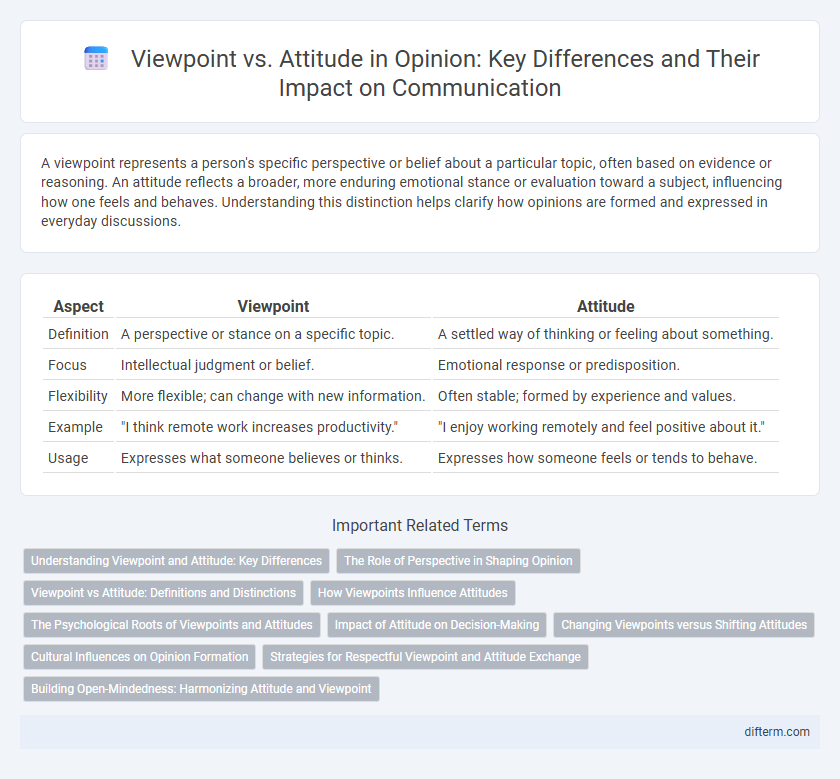A viewpoint represents a person's specific perspective or belief about a particular topic, often based on evidence or reasoning. An attitude reflects a broader, more enduring emotional stance or evaluation toward a subject, influencing how one feels and behaves. Understanding this distinction helps clarify how opinions are formed and expressed in everyday discussions.
Table of Comparison
| Aspect | Viewpoint | Attitude |
|---|---|---|
| Definition | A perspective or stance on a specific topic. | A settled way of thinking or feeling about something. |
| Focus | Intellectual judgment or belief. | Emotional response or predisposition. |
| Flexibility | More flexible; can change with new information. | Often stable; formed by experience and values. |
| Example | "I think remote work increases productivity." | "I enjoy working remotely and feel positive about it." |
| Usage | Expresses what someone believes or thinks. | Expresses how someone feels or tends to behave. |
Understanding Viewpoint and Attitude: Key Differences
Viewpoint represents an individual's perspective shaped by personal experiences and beliefs, while attitude reflects a consistent emotional response toward a subject or situation. Understanding the distinction between viewpoint and attitude is crucial for accurately interpreting communication and behavior. Viewpoints are cognitive and flexible, whereas attitudes tend to be affective and stable over time.
The Role of Perspective in Shaping Opinion
Perspective fundamentally shapes opinion by influencing how individuals interpret information and experiences. Viewpoints, as specific manifestations of perspective, provide a framework for evaluating facts, while attitudes reflect deeper emotional and cognitive predispositions toward a subject. Understanding this dynamic reveals how varying perspectives lead to diverse opinions even when confronted with identical data.
Viewpoint vs Attitude: Definitions and Distinctions
Viewpoint refers to an individual's specific perspective or opinion on a particular subject, often shaped by personal experiences and knowledge. Attitude encompasses a broader predisposition or emotional stance toward people, objects, or ideas, influencing consistent patterns of behavior. Distinguishing viewpoint from attitude is crucial for understanding how opinions are formed and expressed in various social contexts.
How Viewpoints Influence Attitudes
Viewpoints serve as foundational cognitive frameworks that shape and direct individual attitudes towards people, events, and ideas. As mental positions formed through experience and information processing, viewpoints influence the emotional and behavioral responses encapsulated in attitudes. Understanding the interplay between viewpoints and attitudes is essential for comprehending how beliefs evolve and solidify over time.
The Psychological Roots of Viewpoints and Attitudes
Viewpoints arise from cognitive processes that organize information into coherent beliefs, while attitudes are emotionally charged evaluations shaped by personal experiences and social influences. Neural mechanisms in the prefrontal cortex regulate viewpoint formation through rational analysis, whereas the amygdala plays a crucial role in attitude by processing emotional responses. Understanding these psychological roots reveals how cognitive schemas and affective systems interact to form consistent yet distinct mental frameworks.
Impact of Attitude on Decision-Making
Attitude significantly shapes decision-making by filtering information through personal beliefs and emotions, which influences the final choice more than a mere viewpoint. Unlike a viewpoint, which is a neutral stance on a subject, attitude drives behavior and responses, often biasing judgments toward preferred outcomes. Research in cognitive psychology highlights that positive or negative attitudes can accelerate or hinder decision processes, affecting risk assessment and problem-solving efficiency.
Changing Viewpoints versus Shifting Attitudes
Changing viewpoints involves altering one's perspective based on new information or evidence, reflecting a cognitive adjustment in understanding. Shifting attitudes entails a deeper emotional or evaluative transformation, often influenced by personal experiences or social interactions. Both processes contribute to opinion development but operate through distinct psychological mechanisms.
Cultural Influences on Opinion Formation
Cultural influences significantly shape the distinction between viewpoint and attitude in opinion formation by embedding shared values, norms, and beliefs that guide individual perspectives. Viewpoints are often explicit expressions shaped by cultural narratives, while attitudes reflect deeper, sometimes unconscious, cultural conditioning influencing emotional and behavioral responses. Understanding these cultural dimensions reveals how opinions are not only personal but also socially constructed through collective cultural experiences.
Strategies for Respectful Viewpoint and Attitude Exchange
Respectful viewpoint and attitude exchange strategies include active listening, which fosters understanding by fully concentrating on the speaker's perspective without immediate judgment. Employing empathetic communication promotes openness and reduces defensiveness, enhancing constructive dialogue across differing opinions. Establishing clear boundaries and using non-confrontational language further supports positive interactions, encouraging mutual respect and thoughtful consideration of diverse viewpoints.
Building Open-Mindedness: Harmonizing Attitude and Viewpoint
Building open-mindedness requires harmonizing attitude and viewpoint, as attitude reflects emotional disposition while viewpoint represents cognitive stance. Cultivating a flexible attitude broadens understanding and allows diverse viewpoints to be considered objectively. This synergy enhances critical thinking and empathy, promoting constructive dialogue and inclusive decision-making.
viewpoint vs attitude Infographic

 difterm.com
difterm.com